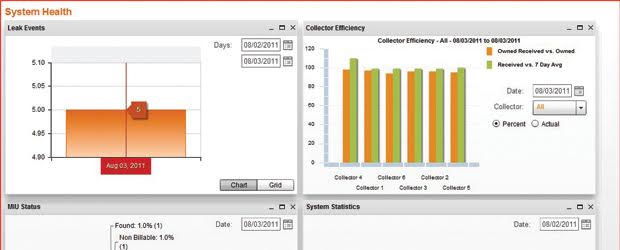
Contributed by Neptune Technology Group
In the fourth year of a severe drought, without runoff, Mammoth Lakes, California, was in danger of running dry. But a switch from monthly to hourly data gave water planners valuable insight to stop water waste. And for the first time, residents and farmers got their own nearly real-time usage data, helping them to become much more effective with their own conservation efforts.
The result? Mammoth Lakes is making its mandatory water conservation targets and then some.
Struggling with the loss of snow pack
The resort town cannot import water and typically depends on snowmelt runoff for much of its water supply. However, because of an ongoing severe drought, the community has been nearly 100% reliant upon groundwater wells.
The Mammoth Lakes Community Water District targeted a 30% reduction in water use, beyond the 20% mandated by the state. It changed irrigation schedules, curbed the washing down of hard surfaces and eliminated car washing except at commercial establishments.
In the early stages of the drought, Utility General Manager Pat Hayes and his team targeted larger accounts using the most water for irrigation, developing a “maximum applied water allowance” to address overwatering. At the time, the District collected consumption hourly interval data on-site from a select portion of the meter population, a process that involved truck rolls and took ten minutes per visit.
 Getting everyone involved in conservation
Getting everyone involved in conservation
Seeking a better solution to increase conservation, one that would encompass all 3,600 or so accounts while replacing antiquated, low-resolution registers, Mammoth Lakes’ dedicated and progressive staff began implementing Neptune’s R450™ System for fixed network AMI in July 2014.
Hayes appreciates the hourly interval data available through Neptune’s E-Coder® technology for frequent analysis. “We went from one data point per month to 24 each day for every meter. And the resolution allows us a view into the system we never had before.”
200 water leaks plugged, 32 million gallons saved
Hayes said it’s easy to identify customers with continuous water usage over a 24-hour period who might have potentially costly leaks.
“The single-family homes are the easiest for us to identify,” he said. “Thanks to the R450 System’s hourly data, we’ve been able to contact close to 200 residents with suspected leaks, resulting in a projected annual savings of 32 million gallons.”
The response to these calls has been even more positive than expected. “We had one lady we called whose all-night water consumption turned out to be a leak in her basement. She was grateful that it was caught in time before it could cause major damage.”
New tool for education efforts
Utilizing detailed AMI data to help educate customers on their usage has greatly assisted Mammoth Lakes in meeting its goal of reducing water consumption by 30% over 2013 levels. In fact, in July 2015, the District reduced consumption by 38%.
“We’ve had a great response from our community,” said District Project Specialist Betty Hylton. “People are reducing indoor water use and cutting down on irrigation, even letting some areas turn brown.”
Hylton specifically mentioned how the District is providing detailed irrigation schedule reviews for irrigation accounts. “These accounts have a monthly allotment based on their landscape size. Many call in to check on their usage because they don’t want a violation for over watering. We’re able to give specific consumption numbers and project monthly usage, telling them, ‘Every time you run an irrigation cycle, you use 6,000 gallons.’ We don’t have to drive to the site. I just log onto the computer for the data.”
Keeping an Hourly Eye on Lawns and Leaks
Hayes said, “With the hourly data, we can determine what’s irrigation versus indoor consumption and easily pick up non-compliance (for water restrictions) either through time of day or day of use for an individual customer.”
“It’s extremely effective to see data for each customer and utilize the graphs to show them how much water they’re using,” said Hylton. “It’s so clear-cut. We don’t have to drive around town to identify customers irrigating outside of their schedule.”
She added that the Neptune System provides concrete data to back our violations. “We are able to find customers' irrigating three days a week instead of the allowed 2 days per week.” For large single-family home properties, eliminating one day of watering can save as much as 10,000 gallons per week.
Before the change out to the R450 System, Mammoth Lakes could only retrieve hourly consumption from select meters in slow, one-meter-at-a-time fashion. Now the District can view the entire system’s consumption with a few clicks of the mouse.
“It’s opened up this kind of attention for single-family homes,” said Hylton, “expanding the number of customers we can reach out to.”
Hayes agreed, saying, “We can look at all accounts, using less manpower, thanks to the System’s automation.”
“We run leak reports for each neighborhood each week,” said Hylton. “We open each account on the report to determine the size of the leak, call the customer to notify them, and provide suggestions on leak detection. The following week when the leak report is run, we can see whether or not the customer has fixed their leak. Sometimes, customers call the District to verify if their leak has been fully repaired."
Boosting Water Efficiency and Customer Conservation
From system-wide, automated fixed network meter reading to high-resolution leak detection to hourly consumption monitoring, the Mammoth Lakes Community Water District is leveraging the capabilities of the R450 System to conserve water now and in the future.
“Having high-resolution hourly interval data allows us to effect change in customer behavior,” said Hayes. “We’re in the fourth year of an extraordinarily severe drought, with no surface water, so conservation has to be front and center. Without Neptune’s R450 System in place, and making use of it on a daily basis, we’d be more limited in what we could do.”



